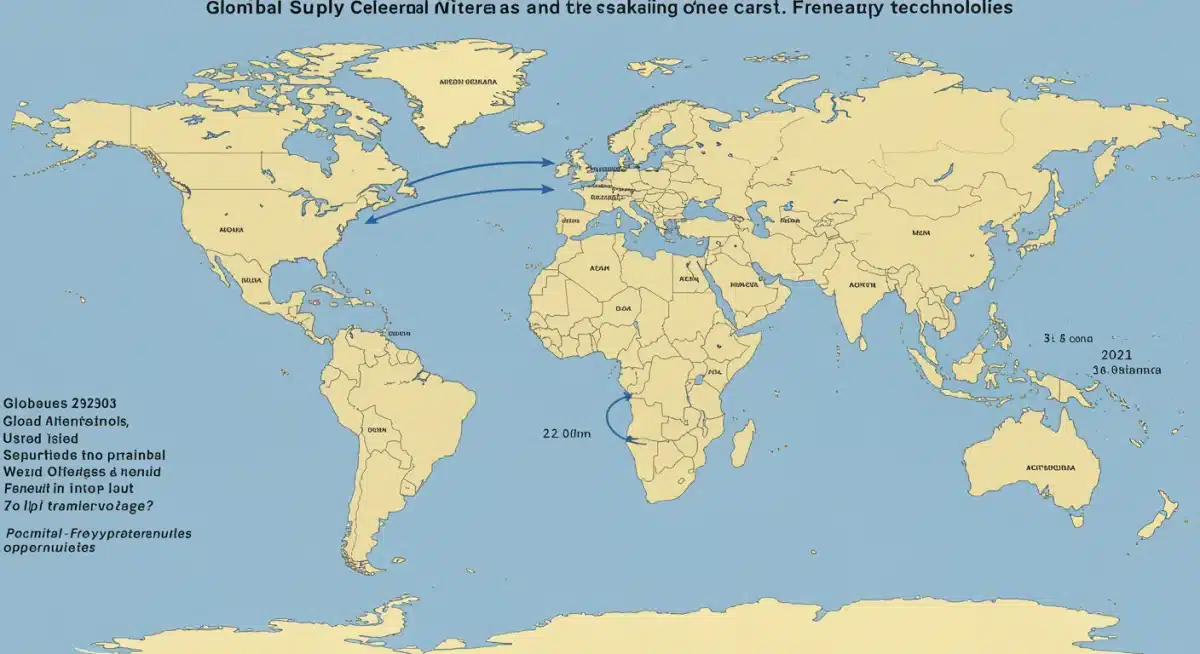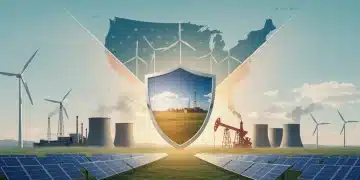Economic Implications of Global Energy Transitions for the U.S. by 2030

The global energy transition will reshape the U.S. economy by 2030, driving shifts in investment, employment, and industrial landscapes while influencing its geopolitical standing.
The world is on the cusp of a profound energy transformation, and the US energy transition economic landscape by 2030 will be significantly shaped by these global shifts. Understanding these complex dynamics is crucial for policymakers, businesses, and citizens alike. What does this mean for America’s future?
understanding the global energy transition
The global energy transition refers to the worldwide shift from fossil fuel-based energy systems to more sustainable and renewable sources. This transition is driven by a confluence of factors, including increasing concerns about climate change, technological advancements in renewable energy, and geopolitical considerations regarding energy security. Its implications are far-reaching, touching every aspect of national and international economies.
For the United States, this transition represents both immense challenges and unparalleled opportunities. The nation, historically a major consumer and producer of fossil fuels, faces the complex task of decarbonizing its economy while maintaining economic stability and competitiveness. The pace and nature of this shift will determine its economic trajectory in the coming decade.
drivers of change
- Climate Imperatives: Growing scientific consensus and public demand for action on climate change are pushing governments and industries towards cleaner energy.
- Technological Innovation: Rapid advancements in solar, wind, battery storage, and smart grid technologies are making renewables increasingly cost-effective.
- Geopolitical Shifts: Reducing reliance on volatile global oil markets enhances national energy security and autonomy.
- Economic Incentives: Government policies, subsidies, and carbon pricing mechanisms are accelerating investment in green technologies.
The convergence of these drivers creates an unstoppable momentum. The U.S. must navigate these forces thoughtfully to realize the full economic potential of the transition. Failing to adapt could lead to significant economic disadvantages, while proactive engagement could secure a leading position in the new global energy order.
In essence, the global energy transition is not merely an environmental movement; it is a fundamental economic restructuring. The United States’ response, including its policy frameworks and private sector investments, will largely define its economic standing and prosperity in the decade leading up to 2030 and beyond. This foundational shift demands a comprehensive understanding of its multifaceted economic implications.
economic impacts on traditional energy sectors
The U.S. has a long and storied history with traditional energy sectors, particularly oil, gas, and coal. The global energy transition will inevitably exert significant pressure on these industries, leading to both contraction and transformation. Understanding these impacts is crucial for managing the economic fallout and facilitating a just transition for affected communities and workforces.
As renewable energy sources become more prevalent and cost-competitive, demand for fossil fuels is projected to decrease in certain sectors, particularly power generation. This decline will have direct consequences for states heavily reliant on fossil fuel extraction and processing, potentially leading to job losses and reduced tax revenues. However, the picture is complex, as natural gas may serve as a transitional fuel, and petrochemical demand could remain robust.
job displacement and creation
One of the most immediate concerns is the potential for job displacement in coal mining, oil and gas extraction, and related support services. Communities built around these industries could face severe economic hardship. However, the burgeoning renewable energy sector is simultaneously creating new jobs, often requiring different skill sets.
- Coal Industry: Continued decline in coal-fired power generation will accelerate job losses in mining and related transportation.
- Oil and Gas: While demand for oil and gas may persist, particularly in transportation and industrial applications, investment shifts towards renewables could temper growth and employment in these sectors.
- Refining and Petrochemicals: These sectors may see continued demand for their products, but efficiency improvements and alternative feedstocks could alter their employment landscape.
Addressing job displacement requires proactive policies, including retraining programs, educational initiatives, and economic diversification strategies for affected regions. The goal is to ensure that workers from traditional energy sectors can transition into new roles within the growing green economy, mitigating economic disruption.
Beyond direct employment, the transition also impacts the vast supply chains supporting traditional energy. Manufacturers of drilling equipment, pipelines, and specialized machinery will need to adapt or diversify. The economic implications are not just about raw energy production but the entire ecosystem built around it. Successfully managing this transition will require thoughtful planning and significant investment in new infrastructure and workforce development programs.
growth of renewable energy and green technologies
Conversely, the global energy transition presents a monumental growth opportunity for the U.S. in renewable energy and green technologies. This sector is poised to be a significant driver of economic expansion, job creation, and technological innovation through 2030. Investment in solar, wind, geothermal, hydropower, and advanced battery storage is surging, creating a new industrial landscape.
The U.S. has a strong foundation in research and development, which positions it well to lead in emerging green technologies such as carbon capture, advanced nuclear, and hydrogen. This leadership can translate into significant export opportunities and strengthen the nation’s competitive edge in the global market. Furthermore, domestic manufacturing of renewable components can create resilient supply chains and high-paying jobs.

investment and innovation
Significant capital investment is flowing into renewable energy projects and related infrastructure. This includes private sector funding, venture capital, and government incentives designed to accelerate deployment and innovation. The scale of this investment is transforming local economies and fostering new business models.
- Solar Power: Continued cost reductions and efficiency gains are driving widespread adoption, from utility-scale farms to residential installations.
- Wind Energy: Both onshore and offshore wind projects are expanding rapidly, leveraging advanced turbine technologies.
- Battery Storage: Essential for grid stability and electric vehicles, battery technology is a critical area of innovation and investment.
- Electric Vehicles (EVs): The burgeoning EV market is creating demand for charging infrastructure, battery manufacturing, and related services, revolutionizing the automotive industry.
The growth of green technologies is not limited to energy generation. It extends to energy efficiency, sustainable agriculture, waste management, and smart city infrastructure. These interconnected sectors offer diverse opportunities for economic development and job creation across various skill levels, from engineering and manufacturing to installation and maintenance.
The U.S. has the potential to become a global leader in the green economy, provided it maintains a supportive policy environment and continues to foster innovation. The economic benefits include not only direct job creation but also increased energy independence, reduced healthcare costs from improved air quality, and enhanced national security. This shift represents a generational opportunity to build a more resilient and sustainable economy.
policy frameworks and regulatory landscape
The success of the U.S. energy transition economic strategy hinges significantly on the policy frameworks and regulatory landscape established by federal, state, and local governments. Consistent and forward-looking policies are essential to de-risk investments, incentivize innovation, and ensure a smooth, equitable transition. The lack of a clear, stable policy environment can deter investment and slow progress.
Key policy tools include tax credits, grants, loan programs, and carbon pricing mechanisms. For instance, extensions of tax credits for renewable energy projects have historically spurred significant growth. State-level renewable portfolio standards (RPS) also play a crucial role in mandating a certain percentage of electricity generation from renewable sources, creating market demand.
key policy considerations
- Investment Incentives: Tax credits (e.g., Investment Tax Credit, Production Tax Credit) and direct grants are vital for making renewable projects financially viable.
- Regulatory Streamlining: Simplifying permitting processes for renewable energy infrastructure and transmission lines can accelerate project deployment.
- Carbon Pricing: Mechanisms like carbon taxes or cap-and-trade systems can internalize the cost of carbon emissions, making fossil fuels less competitive.
- Infrastructure Modernization: Policies supporting the upgrade and expansion of the national electricity grid are crucial for integrating intermittent renewable sources.
Beyond incentives, regulations addressing emissions standards, energy efficiency in buildings, and vehicle fuel economy also contribute to the overall energy transition. These policies collectively shape the market, guiding private sector decisions towards cleaner energy solutions. The interplay between federal and state policies is particularly important, as states often serve as laboratories for innovative approaches before they gain national traction.
Moreover, international climate agreements and trade policies can influence the U.S. energy transition by setting global standards and opening new markets for green technologies. The U.S.’s role in global climate diplomacy can also impact its domestic policy direction and foster international collaboration on clean energy development. A coherent and adaptive policy framework is paramount for maximizing the economic benefits and minimizing the disruptions of the energy transition.
geopolitical and trade implications
The global energy transition will fundamentally alter geopolitical dynamics and international trade relationships, with significant implications for the U.S. by 2030. As nations shift away from fossil fuels, the strategic importance of oil-producing regions may diminish, while new geopolitical alliances and rivalries could emerge around critical minerals and green technologies.
For the U.S., becoming a leader in renewable energy technology and production can enhance its energy independence, reducing its vulnerability to global supply shocks and political instability in energy-rich regions. This shift can also create new avenues for diplomatic influence and strengthen partnerships with countries pursuing similar decarbonization goals. However, it also introduces new dependencies, particularly on the supply chains for critical minerals.

new trade dependencies and opportunities
The transition away from fossil fuels means a reduction in oil and gas imports and exports for many nations, including the U.S. However, it creates new dependencies on critical minerals like lithium, cobalt, and rare earth elements, which are essential for batteries, electric vehicles, and wind turbines. The U.S. currently relies heavily on imports for many of these materials, primarily from China.
- Critical Mineral Supply Chains: Securing reliable and ethical sources of critical minerals will be a major geopolitical challenge, driving new trade agreements and potentially domestic mining initiatives.
- Green Technology Exports: The U.S. has an opportunity to become a leading exporter of renewable energy technologies, components, and expertise, boosting its trade balance.
- International Collaboration: Partnerships with allies on research, development, and deployment of clean energy solutions can strengthen economic ties and accelerate global decarbonization.
- Carbon Border Adjustments: The potential implementation of carbon border adjustment mechanisms by other nations could impact U.S. exports if its domestic carbon pricing policies are perceived as insufficient.
The geopolitical landscape will also be shaped by the race for technological supremacy in green industries. Nations that lead in developing and deploying advanced renewable energy solutions, battery storage, and smart grid technologies will gain a significant economic and strategic advantage. The U.S. must ensure it remains at the forefront of this innovation race to maintain its global competitiveness.
Ultimately, the global energy transition offers the U.S. a chance to redefine its role in the world, shifting from a major consumer of fossil fuels to a leader in sustainable energy. This requires not only domestic investment but also a strategic approach to international relations, trade, and supply chain management to navigate the evolving geopolitical landscape effectively.
social and labor market transformations
Beyond the direct economic shifts, the global energy transition will induce significant social and labor market transformations within the U.S. by 2030. These changes will impact communities, educational systems, and the overall distribution of wealth and opportunity. Ensuring a just and equitable transition is paramount to avoid exacerbating existing social inequalities.
The shift from fossil fuels to renewables will necessitate a retraining and upskilling of the workforce. Workers in coal mines, oil rigs, and gas pipelines may require new skills to transition into roles in solar installation, wind turbine maintenance, or electric vehicle manufacturing. This requires substantial investment in vocational training, community colleges, and apprenticeship programs.
workforce development and equity
Addressing the needs of displaced workers and fostering new talent for the green economy is a critical challenge. Policies must be designed to support workers through this transition, providing not just training but also job placement assistance and economic support for communities facing structural changes.
- Retraining Programs: Government and industry-led initiatives to re-skill workers from traditional energy sectors for roles in renewable energy and green technology.
- STEM Education: Increased focus on science, technology, engineering, and mathematics education to prepare the next generation for green jobs.
- Community Support: Economic development programs for communities historically reliant on fossil fuels, helping them diversify their economies.
- Equity Considerations: Ensuring that the benefits of the green economy are accessible to all demographic groups, including underserved communities, and that job creation aligns with principles of environmental justice.
The energy transition also has implications for public health. Reduced air pollution from burning fossil fuels can lead to significant improvements in public health outcomes, lowering healthcare costs and increasing productivity. These indirect economic benefits, though harder to quantify, are substantial and contribute to overall societal well-being.
Furthermore, the decentralization of energy production through rooftop solar and community grids can empower local communities and create new opportunities for local ownership and wealth creation. This shift can foster greater energy resilience and self-sufficiency, particularly in remote or vulnerable areas. Managing these social and labor market transformations effectively will be key to harnessing the full potential of the energy transition for all Americans.
challenges and opportunities for u.s. competitiveness
The global energy transition presents a dual landscape of formidable challenges and unprecedented opportunities for U.S. competitiveness on the world stage. By 2030, the U.S. must strategically navigate these complexities to secure its economic leadership and ensure long-term prosperity. The ability to innovate, adapt, and invest wisely will determine its standing in the new energy order.
One significant challenge lies in the sheer scale of the transformation required. Decarbonizing an economy as large and complex as that of the U.S. demands massive investment in new infrastructure, technologies, and workforce development. This requires sustained political will and a cohesive national strategy, which can be difficult to achieve amidst political polarization. Furthermore, competition from other leading nations in green technology is intensifying.
maintaining a competitive edge
To maintain and enhance its competitiveness, the U.S. needs to foster an environment conducive to innovation and market growth in green sectors. This includes not only direct investment but also intellectual property protection, research funding, and international collaboration.
- Technological Leadership: Investing in R&D for next-generation clean energy technologies, such as advanced energy storage, fusion power, and sustainable aviation fuels.
- Domestic Manufacturing: Incentivizing the onshoring of manufacturing for renewable energy components and critical minerals processing to reduce supply chain vulnerabilities.
- Skilled Workforce: Developing a robust educational and training ecosystem to ensure a continuous supply of skilled labor for the green economy.
- Market Access: Advocating for fair trade practices and open markets for U.S. green technology exports, while addressing potential trade barriers.
Beyond these, the U.S. must also address the challenge of stranded assets in traditional energy sectors, managing the economic decline of these industries without destabilizing regional economies. This requires careful planning and significant support for diversification efforts in affected areas. The transition must be managed in a way that minimizes economic disruption and maximizes new opportunities.
However, the opportunities are equally vast. By leading the global energy transition, the U.S. can create millions of new jobs, stimulate economic growth, enhance energy security, and improve public health. It can also reassert its leadership in combating climate change, influencing global standards and fostering international cooperation. The strategic choices made in the coming years will be pivotal in shaping the U.S.’s economic future and global standing by 2030 and beyond.
| Key Aspect | Brief Description |
|---|---|
| Traditional Energy Shift | Decline in fossil fuel demand impacts job markets and regional economies, necessitating diversification and retraining. |
| Renewable Sector Boom | Significant growth in solar, wind, and battery technologies drives job creation and investment in green industries. |
| Policy & Regulation | Government incentives, tax credits, and regulatory frameworks are crucial for guiding market behavior and accelerating transition. |
| Geopolitical Impact | New dependencies on critical minerals and opportunities for U.S. leadership in green tech reshape global power dynamics. |
frequently asked questions about the energy transition
Energy prices could fluctuate. While renewable energy costs are decreasing, initial investments in infrastructure and grid upgrades might exert upward pressure. However, reduced reliance on volatile fossil fuel markets could lead to greater long-term stability and potentially lower average costs for consumers.
Industries related to renewable energy manufacturing, installation, and maintenance (solar, wind, batteries), electric vehicle production, smart grid technology, and energy efficiency solutions are poised for significant growth and investment. Digital services supporting energy management will also thrive.
Projections suggest the green energy sector will create a net increase in jobs. While some jobs in fossil fuel industries may be displaced, new roles in renewable energy, manufacturing, and related services are expected to outpace losses, especially with robust retraining programs.
The U.S. can mitigate risks by investing in domestic critical mineral extraction and processing, diversifying international sourcing, fostering recycling technologies, and building strategic alliances with countries rich in these resources, reducing over-reliance on single suppliers.
Government policy is pivotal. It will drive the transition through tax incentives, regulatory frameworks, infrastructure investments, and research funding. Clear, stable, and long-term policies are essential to attract private capital and accelerate the shift towards a sustainable energy future.
conclusion: charting a sustainable economic future
The US energy transition economic landscape by 2030 will be profoundly reshaped by global energy shifts. This transformation demands strategic foresight and robust action from all sectors of society. While the challenges of transitioning away from traditional energy sources are significant, the opportunities for economic growth, technological leadership, and enhanced national security are even greater. By investing in renewable energies, modernizing infrastructure, and fostering a skilled workforce, the U.S. can not only mitigate the risks but also emerge as a global leader in the new green economy. The decisions made today will determine America’s prosperity and influence for decades to come, underscoring the critical importance of a proactive and inclusive approach to this inevitable energy evolution.





